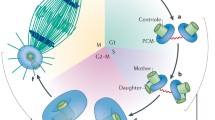Summary
The mammalian centrosome monoclonal antibody MPM-13 recognized component(s) of the well defined MTOC basal-body root complex in the green plantChlamydomonas. The antibody reaction coincided in location with the basal-body root complex and the cruciate nature of the staining pattern corresponded to the configuration of the root microtubules. During mitosis the behaviour of MPM-13 stained material mirrored the duplication, separation and migration to the spindle poles of the basal body-root complex. It is suggested that conserved MTOC components were recognized and that these may have retained a similar, perhaps universal, function in microtubule organization.
Similar content being viewed by others
Abbreviations
- BSA:
-
bovine serum albumin
- DAPI:
-
4,6-diamidine-2-phenylindole dihydrochloride
- mt:
-
mating type
- MT:
-
microtubule
- MTOC:
-
microtubule organizing centre
- PFA:
-
paraformaldehyde
- PBS:
-
phosphate buffered saline
References
Brinkley BR (1985) Microtubule organizing centers. Ann Rev Cell Biol 1: 145–172
Calarco-Gillam PD, Siebert MC, Hubble R, Mitchison T, Kirschner M (1983) Centrosome development in early mouse embryos as defined by an autoantibody against pericentriolar material. Cell 35: 621–629
Coss RA (1974) Mitosis inChlamydomonas reinhardtii basal bodies and the mitotic apparatus. J Cell Biol 63: 325–329
Gaffal KP (1988) The basal body-root complex ofChlamydomonas reinhardtii during mitosis. Protoplasma 143: 118–129
Harper JDI, Mitchison JM, Williamson RE, John PCL (1989) Does the autoimmune serum 5051 specifically recognize microtubule organizing centres in plant cells? Cell Biol Int Rep 13: 471–483
Harris EH (1989) TheChlamydomonas sourcebook: a comprehensive guide to biology and laboratory use. Academic Press, San Diego
Pickett-Heaps (1975) Green algae-structure, reproduction and evolution of selected genera. Sunderland, MA, Sinauer
Rao PN, Zhao J, Ganju RK, Ashorn CL (1989) Monoclonal antibody against the centrosome. J Cell Sci 93: 63–69
Rollins M, Harper J, John P (1983) Synthesis of individual proteins, including tubulins and chloroplast membrane proteins, in synchronous cultures of the eukaryoteChlamydomonas reinhardtii. Elimination of the periodic changes in protein synthesis and enzyme activity under constant environmental conditions. J Gen Microbiol 129: 1899–1919
Snyder M, Davis RW (1988) SPA 1: a gene important for chromosome segregation and other mitotic functions inS. cerevisiae. Cell 54: 743–754
Weiss RL (1984) Ultrastructure of the flagellar roots inChlamydomonas gametes. J Cell Sci 67: 133–143
Author information
Authors and Affiliations
Rights and permissions
About this article
Cite this article
Harper, J.D.I., Rao, P.N. & John, P.C.L. A monoclonal antibody to animal centrosomes recognizes components of the basal-body root complex inChlamydomonas . Protoplasma 153, 208–211 (1990). https://doi.org/10.1007/BF01354006
Received:
Accepted:
Issue Date:
DOI: https://doi.org/10.1007/BF01354006




